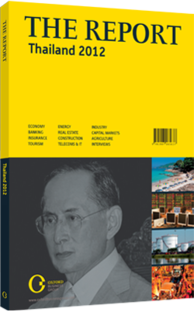High five: A look at the largest players
Thailand’s roster of banks and financial services companies include the universal banking model, but even among larger lenders differentiation by specialty and focus is pronounced. Among that roster, the following five stand out as the largest and most closely watched:
BANGKOK BANK: Thailand’s largest lender by assets has about 1000 branches, but also focuses on corporate clients through loans and products such as cash management and custodian services. It was the first Thai bank to open an overseas branch and now has 26 abroad, as well as two foreign subsidiaries and one representative office. Foreign expansion has included most countries in the ASEAN area – with Malaysian branches announced in December 2011 – as well as the US, the UK and Japan. The bank reported a net profit of BT27.34bn ($872m) in 2011, up 11.2% from 2010. Bangkok Bank’s return on equity – 13% at the end of the first quarter – is lower than the 17.88% average of its large peers. Bangkok Bank has forecast loan growth of 6-8% in 2012, in line with economic growth.
KRUNGTHAI BANK: The biggest government lender and the second-largest bank of any type by assets, Krungthai is 60% owned by the government and publicly trades on the Stock Exchange of Thailand. In 2011 net profit rose to BT17.03bn ($543.3m), 14.2% higher than in 2010. Earnings in the third quarter of 2011 lagged the peer group; Krungthai’s 10% profit rise was smallest among the five major lenders. This is partly explained by the bank’s double mandate – in addition to maximizing profits, Krungthai is charged with offering fiscally-friendly lending and deposit rates to ordinary Thais. The bank in November 2011 increased its forecast for loan growth on the year from 7% to 10%. Expectations for 2012 were between 6% and 8% for credit expansion, although the bank is reviewing its business plan to target SMEs, and as such the 2012 figures are subject to change.
SIAM COMMERCIAL BANK (SCB): Currently Thailand’s third-largest lender by assets, SCB often trades spots with Kasikorn Bank, which was at the end of the first quarter of 2012 the fourth-largest player. SCB had BT1.97trn ($62.8bn) in assets at the end of the reporting period, whereas Kasikorn had BT1.86trn ($59.3bn). It exceeded 1000 branches in 2010, and was the first bank to achieve a recapitalisation after the 1997-98 Asian financial crisis. In 2011 the bank reported a net profit of BT36.27bn ($1.16bn), 49.9% higher than in 2010. SCB remains focused on the domestic market instead of pursuing an international presence, but executives told OBG their strategy is to use the bank’s historical strength in commercial lending to gain exposure to the global economy by financing Thai corporations looking to make foreign investments.
KASIKORN BANK: This bank is known for its strength in lending to farmers and SMEs. Created in 1945, a year after Bangkok Bank, Kasikorn had 808 branches as of June 2011. Net income in 2011 was BT24.23bn ($772m), up 20.8% on 2010. As of the end of the first quarter of 2012, Kasikorn led the group in non-interest income, and it and SCB were the two lenders that slid below the average non-performing loans ratio among the top five banks. (Kasikorn was at 2.2%, and SCB at 2.1%.) The bank in October 2011 announced its corporate banking unit will add a focus on factoring loans – buying the accounts receivable of corporations and collecting that owed money as bank profits.
BANK OF AYUDYHA: Though significantly smaller than the other four, with less than half of their assets, Ayudhya is the fifth-largest lender in Thailand after a merger with the Thai financial services operations of GE. In that arrangement, Ayudhya bought GE’s businesses in Thailand, and GE was left with a 32.9% stake in the bank. Assets as of the end of the first quarter of 2012 reached BT976.04bn ($31.14bn). Net profit for 2011 was BT9.26bn ($295m), up 5.4% from 2010’s total. Ayudhya led the top five banks in net-interest margin, at 4.52% against an average of 3.47% in the group. However, its cost of funds was the highest in the group. Several of these metrics are expected to improve once the merged entities achieve increases in efficiency.
You have reached the limit of premium articles you can view for free.
Choose from the options below to purchase print or digital editions of our Reports. You can also purchase a website subscription giving you unlimited access to all of our Reports online for 12 months.
If you have already purchased this Report or have a website subscription, please login to continue.

